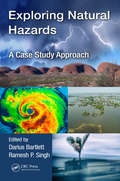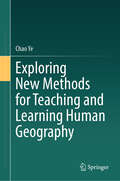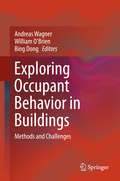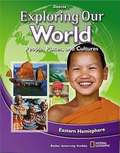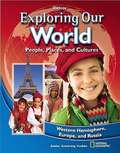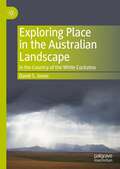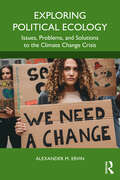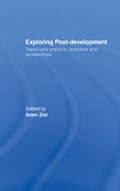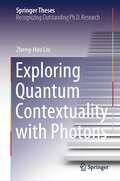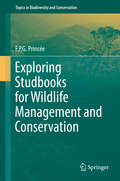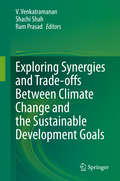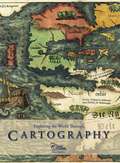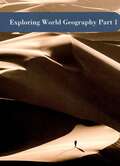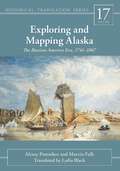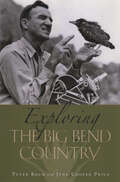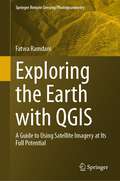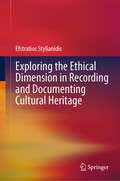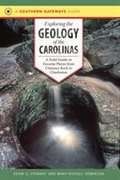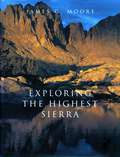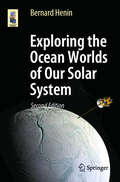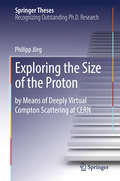- Table View
- List View
Exploring Interstitiality with Mangroves: Semiotic Materialism and the Environmental Humanities (Routledge Environmental Humanities)
by Kate JudithMangroves thrive in intertidal zones, where they gather organisms and objects from land, river, and ocean. They develop into complex ecologies in these dynamic in-between spaces. Mobilising resources drawn from semiotic materialism and the environmental humanities, this book seeks a form of social theory from the mangroves; that is to think interstitiality from the perspective of mangroves themselves, exploring the crafty and tenacious world-making they are engaged in. Three sections weave together theory, science and close observation, responding to calls within the environmental humanities for detailed attention to interactions in marginal spaces and those of interpretative tension. It examines interstitiality by considering theories of difference, relationality, and reflexivity in the context of mangrove socioecological materialities, drawing on influential writers such as Michel Serres, Jacques Derrida, Deborah Bird Rose, Donna Haraway, Brian Massumi and Maurice Merleau-Ponty as theoretical touchstones. Exploring Interstitiality with Mangroves is a lyrically crafted philosophical analysis that will appeal to scholars, researchers and students interested in the developing frontiers of more-than-human post-anthropocentric writing, theory and methodologies. It will be of interest to readers in ecocriticism, environmental humanities, cultural geography, place studies and nature writing.
Exploring Natural Hazards: A Case Study Approach
by Ramesh Singh Darius BartlettThe Sendai Framework for Disaster Risk Reduction 2015–2030 has identified four priority areas for Disaster Risk Reduction: understanding disaster risk; strengthening disaster risk governance to manage disaster risk; investing in disaster risk reduction for resilience and enhancing disaster preparedness for effective response; and to "Build Back Better" in recovery, rehabilitation and reconstruction. Although tremendous progress has been made in recent decades in understanding the workings of the Earth systems and, in particular, its impacts on and responses to human actions, there remains a continuing and pressing need for knowledge that will allow society to simultaneously reduce exposure to global environmental hazards, while also meeting economic development goals. Exploring Natural Hazards: A Case Study Approach, contributes to the knowledge showcasing advanced practices for the monitoring of natural hazards. Through each case study, the book examines mainly hazards arising from processes within the hydrosphere and atmosphere, triggered or exacerbated by inputs to and transfers of energy between environmental components. It discusses the causes of these phenomena, and ways in which improved policy making, sometimes coupled with the application of appropriate modern technologies, can help to reduce people’s exposure to harm. Discussing challenges, lessons learned and recommendations, this book provides a snapshot of issues related to tropical cyclones and typhoons, desertification, floods, lightning as a hazard and the need for alert systems. It is a valuable resource for practitioners and professionals alike, for researchers, students and others who work at the intersection between environmental hazards, sustainable development and social justice.
Exploring New Methods for Teaching and Learning Human Geography
by Chao YeThis book proposes a new and central teaching concept "we are all makers" and innovates the geographical teaching modes and methodology. Geography teaching, especially how to teach geographical thinking, is important and related to the development of the discipline. In this field, the exploration of new teaching methods in non-English speaking countries and regions still needs to grow. Based on the author's experience of teaching geographical thinking and human (cultural) geography for more than ten years, the book links geographical thinking to the realistic cases with new social media tools such as WeChat APP and blog. Under the guidance of these new methods, such as poem, emotional, couplet game, keywords, blog-based teaching, and the like, students are transformed from passive recipients of knowledge to active learners and even creators in the end. The book, which focuses on and pioneers new teaching methodology or methods, is used as a reference by scholars, researchers, practitioners, and readers specialized in fields such as geography, education, and pedagogy.
Exploring Occupant Behavior in Buildings
by Andreas Wagner William O’brien Bing DongThis book is the first to comprehensively cover research methods for building occupant behavior. As this is of growing importance for building design and for building performance optimization, the book aims to provide a sound scientific basis for experimental studies in this field. It introduces the reader to fundamental questions about the topic and unfolds the different fields related to occupant actions and comfort. This is followed by more general questions about developing an appropriate research method and experimental design. A comprehensive overview of sensors for monitoring environmental and also behavioral and action-related quantities helps to set up an experiment. In this context, different experimental environments and data collection methods (in-situ, laboratories, surveys) are introduced and discussed in terms of their suitability for the respective research question. Furthermore, data management and reporting is addressed. The book concludes with fundamental challenges in conducting occupant studies, with chapters on ground truth, ethics and privacy.
Exploring Our World: Eastern Hemisphere
by Richard G. Boehm Francis P. Hunkins David G. ArmstrongAn updatedmiddle school program co-authored by National Geographic,Exploring OurWorldintroduces students to an enriched view of theinterrelationships of geography, history, economics, government, citizenship,and current events--in one compelling package. Suitable for World Geography or World Cultures. A strong geographic thread isinterwoven with history, government, economics and culture to analyze differentregions of the world and issues facing the regions. Exploring Our World isavailable as a full survey or Western Hemisphere, Europe, and Russia and EasternHemisphere.
Exploring Our World: Western Hemisphere, Europe, and Russia
by Richard G. Boehm Francis P. Hunkins David G. ArmstrongWorld geography, world cultures�a world students can understand Exploring Our World: Western Hemisphere, Europe, and Russiais a middle school program co-authored by National Geographic. This program introduces students to an enriched view of the interrelationships of geography, history, economics, government, citizenship, and current events�in one compelling package. A strong geographic thread is interwoven with history, government, and current events to analyze different regions of the world and the issues they face. Suitable for a world geography or world cultures class, this program is also available as a full survey and Eastern Hemisphere. .
Exploring Place in the Australian Landscape: In the Country of the White Cockatoo
by David S. JonesIncluded is a deep ethno-ecological and cross-cultural translation, that takes the reader through both the Western understanding of sense of place as well as the Australian Aboriginal understanding of Country. Both are different intellectual constructions of thoughts, values and ideologies, but which share numerous commonalities due to their archetypal meanings, feelings and values transmitted to humans.
Exploring Political Ecology: Issues, Problems, and Solutions to the Climate Change Crisis
by Alexander M. ErvinThis book explores some of the conditions and underlying causes of the multiple environmental crises facing humanity. Rooted in anthropology, but multidisciplinary in scope, it surveys the many socio-cultural and socio-economic errors, foibles, and follies that brought us to these circumstances. Crucially and uniquely, it outlines an array of viable and practical solutions, some of which are radically different from the current status quo and cultural expectations. The first chapter canvasses the emerging, interdisciplinary field of political ecology, then Part I examines details and trends in agriculture. Part II portrays the threats posed by carbon dependent and combustive technologies as well as the hydro and nuclear energy systems now powering the majority of human actions in developed parts of the world and expanding beyond. The third part turns to consider solutions, including green new deals, de-growth policies, localization, agroecology, alternative energy systems, and many more possibilities. The conclusions engage with urgent moral and legal issues and outline social movement strategies—all related to our collective neglect of climate change—and then finally speculate upon possible futures. This book is key reading for researchers and students interested in climate change across the social and physical sciences and humanities.
Exploring Post-Development: Theory and Practice, Problems and Perspectives (Routledge Studies in Human Geography)
by Aram ZiaiTackling issues surrounding post-development which is arguably one of the most significant debates in the field of north-south relations at the beginning of the twenty-first century. Contributors explore the possibilities and limitations of post-development theory and practice drawing on empirical studies of movements and communities in several continents.
Exploring Quantum Contextuality with Photons (Springer Theses)
by Zheng-Hao LiuThis thesis highlights research explorations in quantum contextuality with photons.Quantum contextuality is one of the most intriguing and peculiar predictions of quantum mechanics. It is also a cornerstone in modern quantum information science. It is the origin of the famous quantum nonlocality and various nonclassical paradoxes. It is also a resource for many quantum information processing tasks and even universal quantum computing. Therefore, the study of quantum contextuality not only advances the comprehension of the foundations of quantum physics, but also facilitates the practical applications of quantum information technology.In the last fifteen years, the study of quantum contextuality has developed from a purely theoretical level to a stage where direct experimental tests become amenable. However, the experimental research on contextuality at the current stage largely focuses on direct validations of some most famous predictions of contextuality, while other forms of contextuality and its practical applications in quantum information science are rarely involved. The research in this thesis is committed to bridge this gap from two directions: (1) to construct and test stronger forms of contextuality and relieve the requirements of contextuality experiments on experimental platforms, and (2) to explore the connections between contextuality and the other concepts in quantum information science and directly demonstrate the application of contextuality in broader scenarios. Specifically, the thesis have discussed the research topics about the relationship between quantum contextuality and nonlocality, the “all-versus-nothing” paradoxes from quantum contextuality, the ore- and post-selection paradoxes from quantum contextuality, and the topological protection and braiding dynamics of quantum contextuality in quasiparticle systems.
Exploring Studbooks for Wildlife Management and Conservation (Topics in Biodiversity and Conservation #17)
by F.P.G. PrincéeMany endangered species of wild animals are managed in captivity through studbooks. In this book these data-rich resources are mined in innovative, integrated and statistically tested ways to maximise information gain for conservation practice – whether for captive or released/reintroduced or managed wild populations. This book is thus an important tool for all species managers, and for students and researchers in small population biology and wildlife conservation.The book's studbook analyses are grouped in three interrelated sections: natural history, demography and genetics. Statistical tests to determine the significance of results or to compare results between subgroups are undertaken throughout. Real studbooks of a variety of species, e.g. cranes, wolverines, blesbok, illustrate the practical applications and interpretations of the analyses and statistics. The “natural history” section presents analyses to determine baseline species information such as litter size, inter-birth interval, longevity and seasonality. “Demography” covers census(-style) analyses, age-class based life tables, comparative survival analyses and population projections. Solutions for dealing with small sample sizes are included.Inbreeding depression and unconscious selection form the main focus of the “genetics” section. Survival and life table analyses are used to assess inbreeding effects. Quantitative genetics methods are applied to natural history traits as a tool to monitor genetic variation. A fourth section on “conservation” shows how data from captive populations can be used where natural history data from wild populations are missing. A real example uses studbook data to inform Population Viability Analysis. The final section deals with issues related to incomplete and missing data and statistical topics.The purpose-written open-source software programs “Population Management Library (PML)” and “studbookR” used for analyses in the book, are available at www.princee.com.
Exploring Synergies and Trade-offs between Climate Change and the Sustainable Development Goals
by Ram Prasad Shachi Shah V. VenkatramananThe existential environmental crisis prompted the United Nations to formulate the Millennium Development Goals at the turn of the 21st century in order to embark on an era of sustainable development. The progress and deficiencies in achieving the Millennium Development Goals provided impetus to the intelligentsia and policymakers to map out the pertinent goals for a sustainable growth trajectory for humanity and the planet. The United Nations’ 2030 Agenda for Sustainable Development, which was adopted in September 2015, took the shape of 17 Sustainable Development Goals (SDGs) and 169 targets. In effect, the 17 Sustainable Development Goals focus on protecting the earth's life support systems for intra- and inter-generational equity and for development that is rooted in sustainability science. Attaining these goals is an uphill task; nevertheless, scientific knowledge, trans and interdisciplinary inquiries, concerted global action and capacity building would provide an enabling environment for achieving the SDGs. This book explores the synergies and trade-offs between climate change management and other SDGs. It highlights the policy imperatives as well as the interrelations between combating climate change and its impacts (SDG 13) and food and nutritional security (SDG 2), water security (SDG 6), soil security (SDG 15), energy security (SDG 7), poverty eradication (SDG 1), gender equality (SDG 5), resilient infrastructure (SDG 9), and sustainable and resilient cities (SDG 11).
Exploring The World Through Cartography
by Classical MultiMediaExploring the World Through Cartography
Exploring World Geography Part 1
by Ray NotgrassExploring World Geography from Notgrass History is a one-year high school course that describes and explains the world God created.
Exploring and Mapping Alaska: The Russian America Era, 1741-1867 (Rasmuson Library Historic Translation)
by Alexey Postnikov Marvin FalkRussia first encountered Alaska in 1741 as part of the most ambitious and expensive expedition of the entire eighteenth century. For centuries since, cartographers have struggled to define and develop the enormous region comprising northeastern Asia, the North Pacific, and Alaska. The forces of nature and the follies of human error conspired to make the area incredibly difficult to map. Exploring and Mapping Alaska focuses on this foundational period in Arctic cartography. Russia spurred a golden era of cartographic exploration, while shrouding their efforts in a veil of secrecy. They drew both on old systems developed by early fur traders and new methodologies created in Europe. With Great Britain, France, and Spain following close behind, their expeditions led to an astounding increase in the world’s knowledge of North America. Through engrossing descriptions of the explorations and expert navigators, aided by informative illustrations, readers can clearly trace the evolution of the maps of the era, watching as a once-mysterious region came into sharper focus. The result of years of cross-continental research, Exploring and Mapping Alaska is a fascinating study of the trials and triumphs of one of the last great eras of historic mapmaking.
Exploring and Optimizing Agricultural Landscapes (Innovations in Landscape Research)
by Lothar Mueller Frank Eulenstein Viktor G. Sychev Nikolai M. DroninThe book informs about agricultural landscapes, their features, functions and regulatory mechanisms. It characterizes agricultural production systems, trends of their development, and their impacts on the landscape. Agricultural landscapes are multifunctional systems, coupled with all nexus problems of the 21th century. This has led to serious discrepancies between agriculture and environment, and between urban and rural population. The mission, key topics and methods of research in order to understanding, monitoring and controlling processes in rural landscapes is being explained. Studies of international expert teams, many of them from Russia, demonstrate approaches towards both improving agricultural productivity and sustainability, and enhancing ecosystem services of agricultural landscapes. Scientists of different disciplines, decision makers, farmers and further informed people dealing with the evolvement of thriving rural landscapes are the primary audience of this book.
Exploring the Big Bend Country
by Peter Koch June Cooper PricePhotographer-naturalist Peter Koch first visited the new Big Bend National Park in February, 1945, on assignment to take promotional pictures for the National Park Service. He planned to spend a couple of weeks—and ended up staying for the rest of his life. Koch’s magnificent photographs and documentary film-lectures Big Bend, Life in a Desert Wilderness and Desert Gold introduced the park to people across the United States, drawing thousands of visitors to the Big Bend. His photographs and films of the region remain among the best ever produced, and are an invaluable visual record of the first four decades of Big Bend National Park. In this highly readable book, Koch’s daughter June Cooper Price draws on the newspaper columns her father wrote for the Alpine Avalanche, supplemented by his photographs, journal entries, and short pieces by other family members, to present Peter Koch’s vision of the Big Bend. The book opens with his first “big adventure,” a six-day photographic trip through Santa Elena Canyon on a raft made from agave flower stalks. From there, Koch takes readers hiking on mountain trails and driving the scenic loop around Fort Davis. He also describes “wax smuggling” and other ways of making a living on the Mexican border; ranching in the Big Bend; the prehistory and Native Americans of the region; collaborating with botanist Barton Warnock on books of Trans-Pecos wildflowers; and the history and beauty of Presidio County, the Rio Grande, and the Chihuahuan Desert. This fascinating blend of firsthand adventures, natural history, and personal musings on anthropology and history creates an unforgettable portrait of both Peter Koch and the Big Bend region he so loved.
Exploring the Earth with QGIS: A Guide to Using Satellite Imagery at Its Full Potential (Springer Remote Sensing/Photogrammetry)
by Fatwa RamdaniWith the rapid advancements in satellite technology, earth remote sensing has become an indispensable tool for a wide range of applications, from environmental monitoring to disaster management. However, the vast amount of data generated by these satellites can be overwhelming for many researchers and practitioners who lack the necessary skills and tools to process and analyze it. This is where QGIS comes in. QGIS is a powerful, open-source Geographic Information System (GIS) software that has been extensively used in the field of earth remote sensing. It provides a user-friendly platform for processing, analyzing, and visualizing satellite imagery, enabling users to unlock the full potential of earth remote sensing data. The purpose of this book is to help researchers and practitioners who lack the necessary skills and tools to process and analyze satellite imagery using QGIS. There are several books that cover the use of QGIS for earth remote sensing, but most of them are either too technical or too general. This book fills this gap by providing a comprehensive and user-friendly guide to using QGIS for earth remote sensing applications. It includes a range of real-world case studies that demonstrate the power and versatility of QGIS for solving complex problems in earth remote sensing. This will provide readers with practical examples of how to use QGIS for earth remote sensing and inspire them to explore new applications and possibilities. The book is intended for GIS professionals, students (undergraduate and graduate), and researchers who are interested in using QGIS for earth remote sensing applications. It will be particularly useful for those who are new to QGIS or who want to expand their knowledge of the software for remote sensing purposes.
Exploring the Ethical Dimension in Recording and Documenting Cultural Heritage
by Efstratios StylianidisThis book addresses the complex challenges and responsibilities involved in preserving humanity's collective heritage. It emphasizes the significance of cultural heritage in shaping community identity and historical continuity, advocating for interdisciplinary collaboration and ethical rigor. The introduction underscores the urgent need to protect artifacts and monuments from threats such as natural disasters and human actions, emphasizing the importance of global cooperation and the use of digital technologies for enhanced preservation. The book covers various aspects of cultural heritage protection, beginning with detailed methods for recording and documenting cultural objects and sites using techniques such as laser scanning and photogrammetry. It offers a global perspective on cultural heritage protection, discussing international conventions, regional agreements, and national laws. Ethical frameworks that guide professionals in the field are explored, addressing issues of ownership, repatriation, privacy, and commercialization, and promoting transparency, integrity, and community involvement. Furthermore, the book examines the historical context and evolving practices in cultural heritage recording and documentation. It emphasizes the need for trustworthy data, focusing on principles of accuracy, completeness, and security. Legal issues, including intellectual property rights, privacy, and ownership, are also explored, with advocacy for international cooperation and harmonization. Equipped with essential knowledge and tools for safeguarding cultural heritage, this book serves as a vital guide for researchers, professionals and policymakers, empowering them to protect cultural heritage for future generations.
Exploring the Geology of the Carolinas: A Field Guide to Favorite Places from Chimney Rock to Charleston (Southern Gateways Guides)
by Kevin G. Stewart Mary-Russell RobersonHow were the Appalachian Mountains formed? Are the barrier islands moving? Is there gold in the Carolinas? The answers to these questions and many more appear in this reader-friendly guide to the geology of North Carolina and South Carolina. Exploring the Geology of the Carolinas pairs a brief geological history of the region with 31 field trips to easily accessible, often familiar sites in both states where readers can observe firsthand the evidence of geologic change found in rocks, river basins, mountains, waterfalls, and coastal land formations.
Exploring the Highest Sierra
by James G. MooreWritten for the general reader with an interest in geology, natural history, and the early explorations of the highest part of California’s Sierra Nevada range, this book is also an indispensable guide for visitors to Sequoia and Kings Canyon National Parks and adjacent areas. Maps, photographs, and geologic guides help visitors understand the formation of the awesome natural features before them. The region was one of the last parts of the United States to be explored, and it was only during the Civil War that the first scientific party attempted a reconnaissance map of the region. They discovered, in the process, that it included the highest mountain then in the United States, Mount Whitney. The book describes the arduous travels of the early explorers, including John C. Fremont and John Muir, and weaves the history of exploration together with modern geologic concepts to show the early naturalists’ contributions to geologic thought. Throughout, all terms that may be unfamiliar to non-geologists are simply and succinctly defined, and the book is richly punctuated with anecdotes, tales, myths, and biographical sketches of colorful characters associated with the region. The book is illustrated with some 224 early etchings and maps, modern photographs, and diagrams, including 44 maps that incorporate 12 historical charts dating back to the earliest explorations. A series of 15 maps (in color) of the region encompassing the parks, all at the same scale, feature such diverse aspects as the trails pioneered by John Muir, the extent of glacial ice during the Ice Age, and the location of geologic faults and epicenters. Geologic guides for the region’s principal roads and trails define the mileage of all lookouts and points of interest so that the visitor can examine the described features at first hand. The southern half (more than 100 miles) of the John Muir trail lies within the region, and the book includes a geologic guide to this high-altitude wilderness trail.
Exploring the Nexus of Geoecology, Geography, Geoarcheology and Geotourism: Proceedings of the 1st Springer Conference of the Arabian Journal of Geosciences (CAJG-1), Tunisia 2018 (Advances in Science, Technology & Innovation)
by Ezzoura Errami Haroun Chenchouni Fernando Rocha Luisa SabatoThis edited volume is based on the best papers accepted for presentation during the 1st Springer Conference of the Arabian Journal of Geosciences (CAJG-1), Tunisia 2018. The book is of interest to all researchers in the fields of Environmental Sciences, Geoecology, Agroforestry, Geography, Geoarcheology and Geotourism. The Mediterranean Basin, Middle East and surrounding regions are ecologically unique due to large differences in climatic, geographical, and geological features, which grant countries of these regions with significant socio-economic potentials in terms of fertile agricultural lands, rich natural resources, and the existence of strategic resources such as crude oil and natural gas. However, the valuation of ecosystem functions, goods and services of natural and cultural heritages and bioressources of these regions is still little known. This volume offers an overview of the latest information and ideas on the physical environment of these regions, assessment and monitoring of natural bioressources including flora and fauna, and the use of cutting-edge methods for the development of sustainable agricultural systems. It gives also new socio-economic insights on geotourism and archaeology. Main topics include:1. Environmental Assessment and Monitoring of Agrisilvicultural Systems2. Environmental Impacts and Restoration Ecology of Natural and Agricultural Habitats3. Investigations and Applications in Environmental Biotechnology4. Spatiotemporal Patterns of Marine Biodiversity and Terrestrial Paleobiodiversity5. Socio-economics of Geotourism and Archaeology
Exploring the Ocean Worlds of Our Solar System (Astronomers' Universe)
by Bernard HeninIn the last 25 years, planetary science experienced a revolution, as vast oceans of liquid water have been discovered within the heart of the icy moons of our Solar System. These subsurface oceans lie hidden under thick layers of ice. We call them ocean worlds. Some of these icy moons, such as Ganymede, may hold two to three times more liquid water than all the water present on Earth, while others, such as Enceladus and Europa, are thought by astrobiologists to be our best hope of finding extraterrestrial life. In this book, we will explore and compare a variety of Solar System ocean worlds, meeting in the process 22 of the most intriguing objects, from the giant asteroid Ceres to the enigmatic, distant Sedna. In doing so, we will also encounter the multiple spacecraft that brought back most of what we know of these worlds (Pioneers, Voyagers, Cassini-Huygens, etc.), as well as the latest scientific research on this new topic. We will also entertain the possibility of life on each of these ocean worlds by assessing their habitability, as ultimately, these ocean worlds might hold the key to answering the fundamental questions in life: How did life appear? Where do we come from? Is there life out there?
Exploring the Ocean Worlds of Our Solar System (Astronomers' Universe)
by Bernard HeninIn the past 25 years, planetary science has undergone a revolution with the discovery of vast oceans of liquid water within the icy moons of our Solar System. These subsurface oceans are concealed beneath thick ice layers. We refer to these moons and similar ocean-bearing planetary objects as ocean worlds. In this 2nd edition, we delve into and compare the latest scientific discoveries on 22 confirmed or potential ocean worlds, ranging from the giant asteroid Ceres and the icy moons Europa and Enceladus to the distant dwarf planets of the outer Solar System such as Pluto, Sedna, and Eris. Along the way, we explore the contributions of multiple spacecraft, such as the Pioneers, the Voyagers, Galileo, Cassini-Huygens, and many others, which have provided much of our current knowledge about these worlds, as well as the latest scientific research on this subject. This book also explores the potential for life on each of the confirmed ocean worlds evaluating their habitability. Ultimately, these might hold the key to answering fundamental questions about life: How did life begin? Is there life beyond Earth? Where do we come from? With contributions from leading planetary scientists at NASA, ESA, and other institutions, this book aims to be the definitive reference for anyone interested in this captivating subject.
Exploring the Size of the Proton
by Philipp JörgThis book is a rare jewel, describing fundamental research in a highly dynamic field of subatomic physics. It presents an overview of cross section measurements of deeply virtual Compton scattering. Understanding the structure of the proton is one of the most important challenges that physics faces today. A typical tool for experimentally accessing the internal structure of the proton is lepton–nucleon scattering. In particular, deeply virtual Compton scattering at large photon virtuality and small four-momentum transfer to the proton provides a tool for deriving a three-dimensional tomographic image of the proton. Using clear language, this book presents the highly complex procedure used to derive the momentum-dissected transverse size of the proton from a pioneering measurement taken at CERN. It describes in detail the foundations of the measurement and the data analysis, and includes exhaustive studies of potential systematic uncertainties, which could bias the result.

